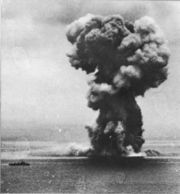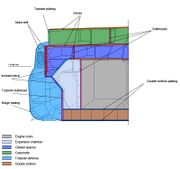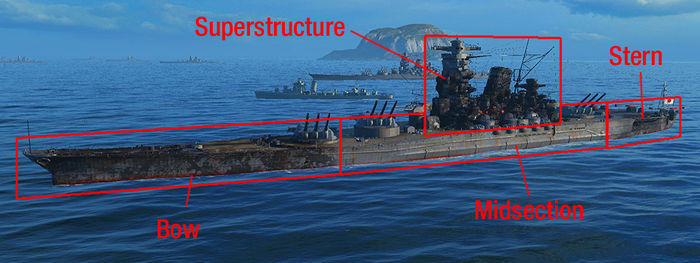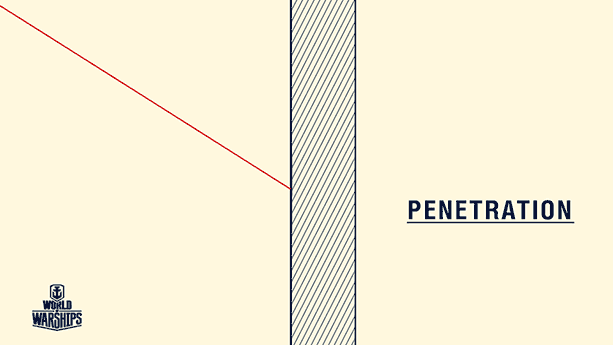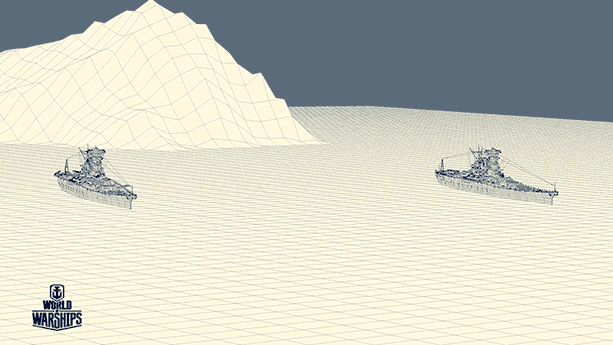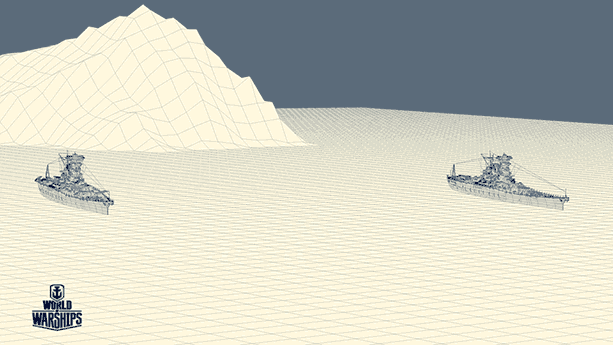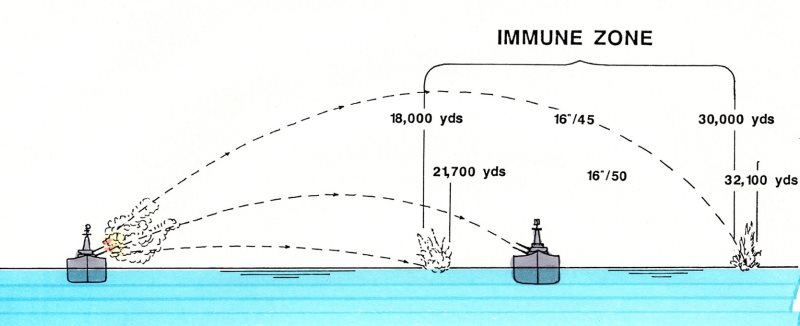Armor Penetration
Contents
Armor
Armor in World of Warships is not just a uniform barrier to be pierced (like in WoT), but rather a kind of multi-layered “cake” that covers a number of construction elements and mechanisms, each having specific armoring. A projectile that enters the ship can encounter up to four or five layers of armor and may be stopped or ricochet at each layer. In this regard the developers attempted to adhere to historical realism and simulate all significant layers of armor. The armor tends to be very heavy: on a typical battleship it takes up around 40% of the total displacement of the vessel. Therefore, battleship designers tried to save some of that weight by placing heavy armor only around the vital parts of the ship: the ammunition and propellant magazines, the propulsion plant, the fire-control, command and communications sections. Most of the other compartments are almost completely unarmored. This approach of providing either total or negligible protection is referred to as "all or nothing". In effect, the scheme accepts vulnerability to medium-caliber and high-explosive shells striking the unarmored sections of the hull, in order to improve resistance against the heaviest armor-piercing shells, while at the same time being able to carry a powerful armament and retain useful speed and endurance.
The ship's vital parts are protected by a citadel, which can be visualized as an open-bottomed (closed top) rectangular armored raft with sloped sides sitting within the hull of the ship. Although it was desirable for the citadel to be as small as possible, the space enclosed was an important source of reserve buoyancy, and helped prevent the ship from foundering when other compartments had flooded. In game, taking the citadel's HP to zero would effectively destroy the ship, even if none of the other compartments were affected.
From the citadel box box, shafts known as barbettes lead upwards to the ship's main gun turrets and conning tower. The ship's magazines are located in or around the turret barbettes, and contain the main caliber shells, as well as the gunpowder charges. Penetrating the citadel armor around the magazine often results in a spectacular one-shot kill.
How can a player know where these important compartments are when he or she fires into the side of an unfamiliar ship? Short of looking up ship's blueprint, an educated guess will have to suffice. The citadel is normally located in the middle of the ship, and is roughly half the ship's length. As a rule-of-thumb, when you have a clear shot at the side of the ship, aim in the middle of the ship (just below the smokestacks), and close to the waterline. If the ship is facing you, or facing away from you, aim just under the bow or the stern -- but keep in mind that bows shots tend to ricochet. The magazines are normally located just under the main caliber turrets.
In addition to belt armor, which protects battleships from direct fire, they also have deck armor that protects them from plunging fire -- shells at extreme engagement ranges tend to hit the top of the ship. However, due to to a large area that would have to be protected, battleships' deck armor is much thinner than the belt armor. As such, shells fired to strike the deck may be able to defeat the armor while those same shells may be incapable of penetrating the side armor of the target vessel.
Compartmentalization
A ship has to be both a military base and a combat vehicle, since it is designed for long autonomous operations. Therefore a significant portion of the ship's interior space is needed for the every-day activities, but has no direct effect on ship's fighting capacity in the critical moments of the battle. A shell that destroyed the ship's laundry room or the galley in an artillery duel would have much less of an effect on combat capability than a shell that hit the magazine or the engine compartment.
That is why, unlike the vehicles of World of Tanks, ships in World of Warships are divided into multiple compartments, each with a different value of hit points (HP). Roughly, the compartments are as follows: bow, stern, citadel, casemate (center part minus the citadel), and the superstructure. The total value of HP for all the compartments is roughly twice the ship's total hit point value ( fighting efficiency): in real life, the ship would be out of battle long before every last portion of it is destroyed.
Each section (except the citadel) has two thresholds, where after each one is reached the damage it receives is reduced. The threshold levels for each section of each ship varies.
- In the initial state, the ship will receive damage normally (x0.33 for shell penetration). The section starts off clean and gets darker as it takes more damage.
- After the first threshold is reached, the damage received is halved (x0.165 dmg for shell penetration). At this stage, the section of the ship is visually blackened.
- Finally, once the second threshold is reached the section stops receiving damage. There is no visual difference to the first threshold, you'll only notice that your shells stop doing damage to the section.
- Regardless of the state of the section, over-penetration will always deal x0.1 dmg and citadel hits will always deal x1.0 damage, even after the section's HP pool is completely depleted.
- If the midsection's second threshold has been reached, all other sections will take damage as if it had passed the first threshold even if it hasn't taken any damage yet. Damage from fire, flooding, over-penetration and citadel hits will not reduce any section's HP pool (but they will still reduce the ship's total HP as normal). A section with no HP left may still burn or flood normally and continue dealing damage to the ship.
HE penetration
Unlike AP shells, the penetration of HE shells does not depend on the impact angle or velocity---rather, each HE shell has a fixed penetration value which is compared to the raw thickness of the armor. The formula for calculating this penetration value depends on a penetration coefficient based on the nation and type of ship. The default coefficient is 1/6 of the shell's diameter for most ships, but 1/4 for Japanese 100mm guns, most British battleships, certain German cruisers, and certain German battleships. This penetration value can be increased by 30% with the Inertia Fuze for HE Shells (IFHE) commander skill. If the armor is greater or equal to this HE pentration value the shell shatters; if the armor is strictly less than this value the shell penetrates. These are summarized in the following list:
Ships with 1/4 penetration coefficient
Japanese 100mm main and secondary guns.
British battleship main guns, except Warspite and Hood.
German battleship main guns and secondary guns of 105mm, 128mm, & 150mm caliber, except the Prinz Eitel Friedrich & Scharnhorst 105mm secondary guns.
German cruiser tier IV+ main guns, Graf Spee & HSF Graf Spee main and 150mm secondary guns and tier VIII+ German cruiser main and secondary guns.
Ships with 1/6 penetration coefficient
All other ships.
The formula for calculating the HE penetration value is as follows.
Gun caliber * the penetration coefficient with the result rounded to the nearest mm (.5 rounds up). This resulting value is the armor thickness that will shatter a HE shell. One mm smaller or less will mean that the HE shell will pen the armor. Instead of multiplying by 1/4 or 1/6, you can instead divide by 4 or 6 as the math is the same. Here are some examples.
127mm / 6 = 21.167mm rounded to 21mm which is the minimum armor thickness that shatters a 127mm HE shell. A 127mm HE shell will penetrate armor of 20mm thickness or less.
152mm / 6 = 25.333mm rounded to 25mm which is the minimum armor thickness that shatters a 152mm HE shell. A 152mm HE shell will penetrate armor of 24mm thickness or less.
203mm / 6 = 33.833 rounded to 34mm which is the minimum armor thickness that shatters a 203mm HE shell. A 203mm HE shell will penetrate armor of 33mm thickness or less.
The formula for calculating the IFHE penetration value is as follows.
If you have a Commander with the IFHE skill, it will add 30% (x1.3) to the HE penetration value of all HE shells on the ship. So while battleship main guns do not benefit from the IFHE skill as a rule (they already have a high HE penetration value), some players will want the IFHE skill for a secondary gun build. The 30% bonus is added to the rounded HE penetration value from the previous formula. The result of the IFHE calculation is always rounded up to find the HE penetration value. Here are some examples.
127mm / 6 = 21.167mm rounded to 21mm. 21mm * 1.3 = 27.3mm rounded up to 28mm. A 127mm HE shell with the IFHE skill will shatter on 28mm or greater of armor thickness and penetrate armor of 27mm thickness or less.
152mm / 6 = 25.333mm rounded to 25mm. 25mm * 1.3 = 32.5mm rounded up to 33mm. A 152mm HE shell with the IFHE skill will shatter on 33mm or greater of armor thickness and penetrate armor of 32mm thickness or less.
203mm / 6 = 33.833 rounded to 34mm. 34mm * 1.3 = 44.2mm rounded up to 45mm. A 203mm HE shell with the IFHE skill will shatter on 45mm or greater of armor thickness and penetrate armor of 44mm thickness or less.
| Ships | Without IFHE | With IFHE |
|---|---|---|
| Default | (armor + 0.5) * 6 | (armor + 0.5) * 6 / 1.3 |
| British battleships German cruisers German battleships |
(armor + 0.5) * 4 |
(armor + 0.5) * 4 / 1.3 |
Example: Shchors has 75 mm of citadel armor. Therefore it would take at least (75 + 0.5) * 6 = 453 mm shell diameter to citadel her with HE. With IFHE this decreases to (75 + 0.5) * 6 / 1.3 = 348.46 mm, or 349 mm since all shell diameters are integers. British battleships, German cruisers, and German battleships without IFHE can citadel Shchors with 302 mm shells or greater. With the addition of IFHE, such ships can citadel her with shells of at least 233 mm diameter.
Armor-Piercing
Unlike HE, the AP shell does damage only if it penetrates the armor. The fuze of the AP shell is initiated after it passes through armor, and historically the fuze times were calculated in a way that would allow the shell to explode after traveling about ten or so meters after passing through the armor; that way the shell exploded around the middle of the battleship. That means that when AP shells are fired at lightly armored and relatively small target, they might over-penetrate -- explode once they passed through the entire ship, or not even explode, if the shell doesn't encounter enough armor to activate the fuze. Let's illustrate the fuzing concept with the Iowa's AP Mark 8 16 inch projectile. Its Mark 21 Base Detonating Fuze (BDF) had a delay of 0.033 seconds. Fuze activation requires a resistance equal to 1.5 inches (3.8 cm) of armor at 0 degrees obliquity or 0.375 inches (1 cm) at 65 degrees obliquity. The muzzle velocity for a new gun and a full charge is 762 meters per second. Therefore, if the shell were to immediately hit an armor plate 1.5 inches thick after exiting the barrel, it would explode 762*0.033 = 25 meters after passing through that armor plate. Most AP shells in game have a fuzing time of 0.033 seconds, but there are shells with as much as 0.1 second fuzing time. As of patch 0.3.1, the armor thickness necessary for AP shell fuzing was as follows (caliber - armor): 410mm - 68mm, 356mm - 59mm, 203mm - 34mm, 155mm - 26mm.
Non-penetrations (bounce/ricochet) will always deal 0 damage, regardless of AP or HE (the latter cannot ricochet). However, HE shells still has a chance to start fires or break modules with its splash damage).
Bounce angles
Bounce or ricochet angles are stated in reference to the perpendicular, as in the illustration below. (Ricochet is not always possible; see Overmatch below.) The angles for AP ricochets are:
- 90-60° -> auto ricochet (90-67.5° for USN 8" shells)
- 60-45° -> chance to ricochet (67.5-45° for USN 8" shells)
- 45-00° -> ricochet doesn't occur
Penetrations deal x0.33 of the shell's listed damage. Whether AP or HE, it must penetrate the armor and detonate inside the ship. Over-penetrations deal x0.10 of the shell's listed damage. Over-penetration is when a shell penetrates the ship through-and-through, before it has a chance to detonate inside the ship. Theoretically HE will never over-penetrate due to its low detonator threshold and shorter fuze. Citadel hits will always deal x1.0 of the shell's listed damage (though citadel over-penetration is still possible, and will only deal x0.10 damage). It is impossible to get a citadel hit on a destroyer, as they no longer have them per se (it was removed in 0.2.4/0.3.0).
Properly angling the ship matters a great deal when the enemy is shooting AP shells: when an AP shell encounters armor at an angle, it has to pass a greater amount of armor for penetration. Additionally, at shallow angles to the surface the shell will simply ricochet, even if it might otherwise be able to penetre. A ricocheting shell may still cause damage, but only to the same ship. For heavy shells vs. thin armor, ricochet cannot occur; see Overmatch below.
There are certain engagement ranges when AP shells will encounter both the belt and the deck armor at fairly large angles, and will have a high probability of either non-penetration or ricochets. The distance at which both plunging fire and direct enemy fire is less effective is called the immunity zone (IZ). Despite the absolutist nature of its name, the immunity zone concept does not imply any sort of invulnerability. A ship fighting within its IZ will still probably suffer when hit, but it is theoretically proof against singularly catastrophic hits to the citadel. (plunging-fire still need more testing, the issue with the capped ranges causing the shells were benefit from it being "auto-bounce" against deck armor)
AP shells can penetrate ship's armor even below the waterline, after traveling through water. The illustration to the right depicts a typical underwater trajectory of an AP shell: (1) - shell enters the water and is fuzed due to rapid deceleration (2) - trajectory angle changed (this happens every time an AP shell hits water) (3) - after a short delay, the fuze explodes the shell. The image also demonstrates two outcomes of an underwater hit: armor penetration, and a ricochet. As of 0.4.1 the underwater hits do not cause flooding.
Overmatch
If the armor thickness is less than 1/14.3 of shell's caliber, a ricochet does not occur regardless of armor encounter angle. See this table for examples.
